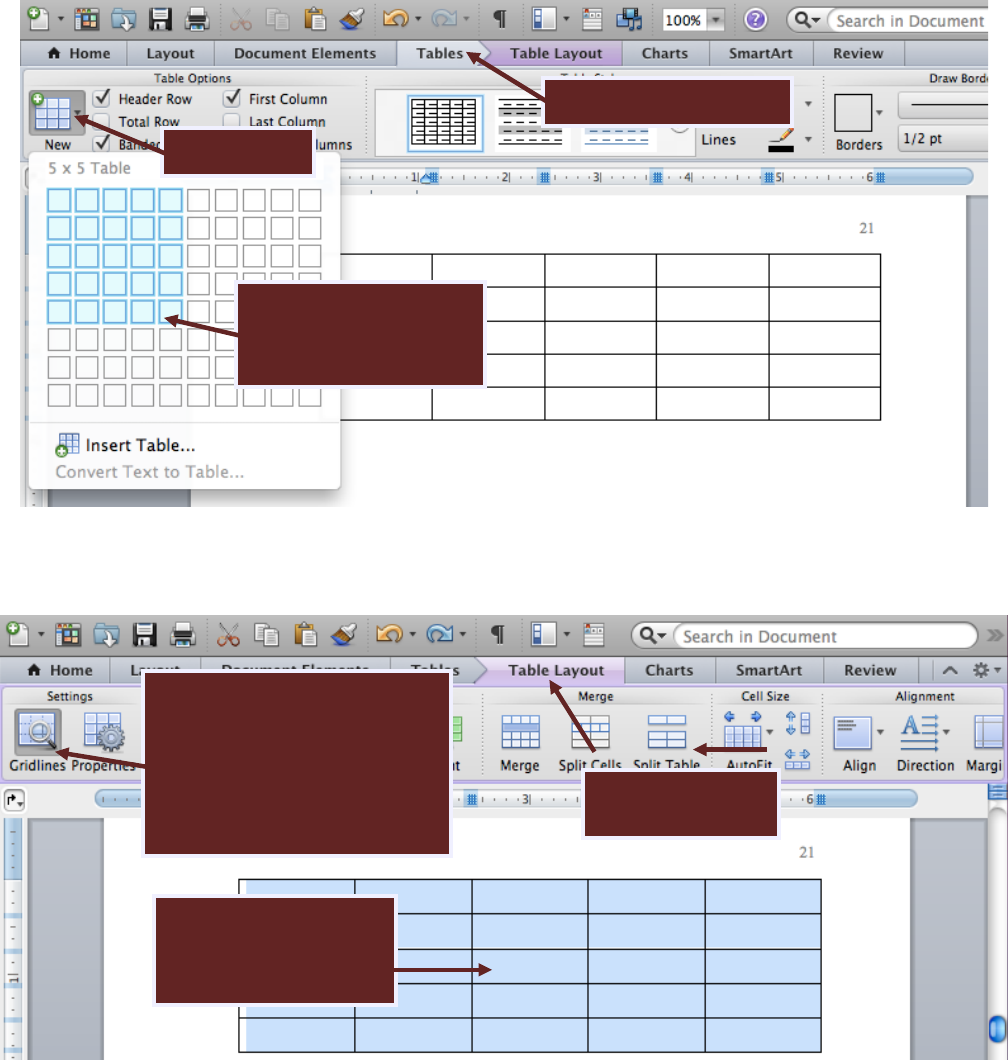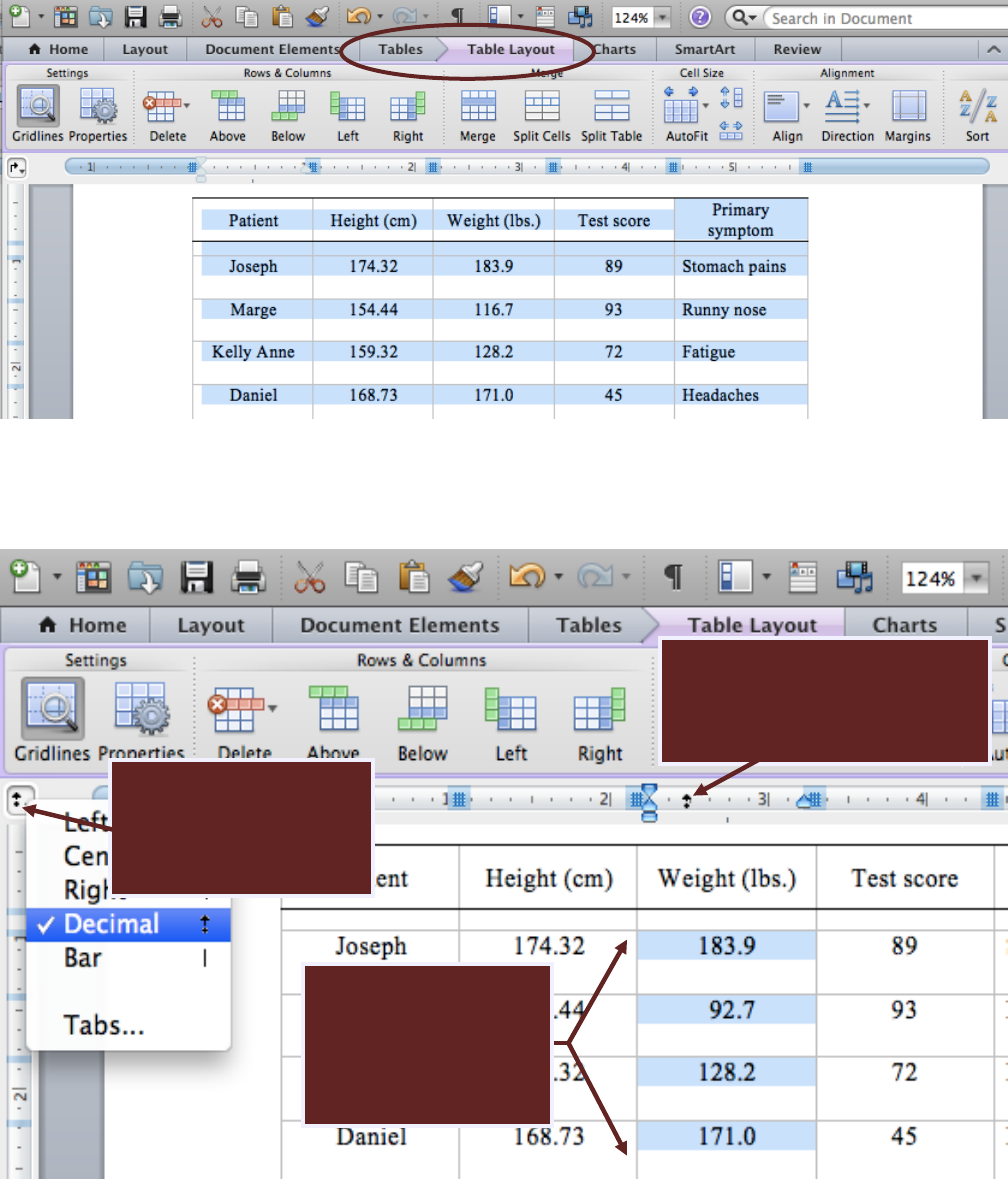
Mac Word 2011 Formatting Tables | Page 1 of 9
How to Format Tables in the American University
Thesis and Dissertation Template
Click to Jump to a Topic
Pasting Tables into the Template (3 Steps)
Creating and Formatting a Table from Scratch (12 Steps)
Formatting Table Notes
Pasting Tables into the Template (3 Steps)
STEP 1. If you already have tables made in Excel or another Word document, you can highlight them, copy them,
and paste them into your thesis or dissertation template. After pasting, you will see a little clipboard appear at
the bottom right of the pasted material. Open the menu and experiment with the different options to see which
gives you the best results. You may still have to do some formatting afterwards. Make sure you consult your
discipline’s preferred style guide for details on border lines, spacing, data alignment, capitalization, and so forth.
If you are pasting from Excel and want to paste your table as an image, you should turn off the gridlines first in
Excel (go to View and uncheck the box that says “Gridlines”). Pasting as an image is sometimes helpful for large
appendix tables, assuming your formatting is clean in the original document.
STEP 2. After you get as close as you can with the formatting, check to make sure your table is within the
allowable margin area by turning on the page gridlines (go to the Layout Tab, then check the box that says
Gridlines toward the right of the screen. If the box is not visible, click Grid Options within the Layout tab
(towards the right) and then check the box to Display Gridlines on Screen.
STEP 3. Check your discipline’s preferred style guide (Turabian, APA, etc.) and format as necessary.

Mac Word 2011 Formatting Tables | Page 2 of 9
Creating and Formatting a Table from Scratch (11 Steps)
The following steps show the basic formatting shared by both Turabian and APA tables. Please see those guides
or your department’s preferred style guide for details and requirements specific to your discipline.
STEP 1. It is not recommended to type rows of data into the main text and use the TAB key to create spaces. This
makes the tables very difficult to format and often causes misrepresentations of the data. You can easily insert a
table as follows:
STEP 2. Turn on the Table Gridlines (not the Page Gridlines).
1. Open the Tables tab.
2. Click New.
3. Choose table size
(you can add more rows
or columns later).
1. Put the cursor
anywhere inside any
table in the document.
2. Open the Table
Layout tab.
3. Select Gridlines. You won’t
notice a change at the
moment because all cells are
covered in border lines, but
you will need the gridlines in
the next step.

Mac Word 2011 Formatting Tables | Page 3 of 9
STEP 3. Remove all border lines from the table.
STEP 4. Add a top and bottom border to the first row.
1. Highlight the
entire table.
3. Open the
Borders menu.
4. Choose None. The black lines will go
away, and now you will see the gray
Table gridlines. These gridlines do not
show or print in the final document;
they just provide a guide to help you
enter data and format the table.
2. Open the
Tables tab.
1. Highlight just
the first row of
the table.
3. Open the
Borders menu.
4. Choose Bottom. Then Repeat
Steps 2 and 3 and Choose Top. You
should now have two black lines,
one at the top and one at the
bottom of the top row of the table.
2. Open the
Tables tab.

Mac Word 2011 Formatting Tables | Page 4 of 9
STEP 5. Add a bottom border to the table.
STEP 6. Add a table title. Highlight the table title and choose Table Title from the styles boxes in the Home tab.
This will ensure that the table title appears in the List of Tables. Consult your discipline’s preferred style guide
for how to format the table number and title and how to capitalize and punctuate appropriately.
2. Open the Home tab.
1. Add your table title.
Don’t worry about
formatting it according
to your discipline’s style
guide yet. That will be
the last step.
4. Choose
Table Title.
3. Open the Styles
menu by clicking
the second down
arrow to the right
of the white boxes
(not shown).
1. Highlight just
the last row of
the table.
3. Open the
Borders menu.
4. Choose Bottom.
2. Open the
Tables tab.
5. Now, consult your department’s preferred
style guide (Turabian, APA, etc.) and add italics,
line spacing, etc. as needed to your table title. If
you add line spaces between the table number
and table title, press SHIFT + ENTER to use soft
carriage returns (this keeps the table number
and title together in the List of Tables).

Mac Word 2011 Formatting Tables | Page 5 of 9
Your table should now look something like this:
STEP 7. Your basic table is almost ready for data entry. By default, the table will be outside the left and right
margins of the document. To see where the allowable margin area is, first activate the page gridlines (these are
different from the table gridlines).
1. Open the Layout tab.
2. Check the
Gridlines box,
or, if it is not
visible, click
Grid Options.
3. Check the box to
Display Gridlines on
Screen.

Mac Word 2011 Formatting Tables | Page 6 of 9
STEP 8. Drag the right and left table borders in to be even or within the page borders (see image below).
Your table should now be lined up with the page margins, like this:
Now, you will probably want to turn off the page gridlines (but leave the Table gridlines) to avoid having so
many crisscrossing lines on the screen while you work.
1. Drag the leftmost table
line to the right, even with
the gray gridded line that
marks the beginning of the
printable area. Then drag
the right side of the table to
the left to meet the other
page margin.

Mac Word 2011 Formatting Tables | Page 7 of 9
STEP 9. Now you are ready to enter your data into the table. Whenever you have the cursor inside of a table,
you can access a variety of table formatting options in the Table Layout and Tables tabs.
STEP 10 (if needed). If you have decimal data in your columns, both Turabian and APA require that you align the
cells vertically on the decimal point:
1. Click the tab button to
the left of the ruler and
choose Decimal from the
pop-up menu.
3. With the data still highlighted,
click one time on the ruler to set
the decimal tab. Then drag the
tab left or right as needed.
2. Highlight the column
data. Left-align the data
(COMMAND + L on the
keyboard or from the
Home tab).

Mac Word 2011 Formatting Tables | Page 8 of 9
STEP 11 (if needed). If you have word data that extends beyond one line in a cell, it often improves readability
to indent the second and following lines:
STEP 12. There are several other intricacies to properly formatting tables, such as aligning numerical and text
data, proper capitalization of headers and cells, abbreviations, table spanners, different types of table notes, etc.
For these issues and more, consult your discipline’s preferred style guide.
Formatting Table Notes
A Table Note style is included in the styles menu in the Home tab at the top of your screen.
First, add your notes according to your discipline’s preferred style guide (both Turabian and APA use very similar
styles for general table notes, specific notes, and probability notes, and Turabian includes additional information
on source notes).
Once you have followed your style guide’s rules, you can highlight the table note(s) and apply the Table Note
Style from the Styles menu in the Home tab to reduce the font size to 10 pt. If you decide to make changes to
the table-note font size or line spacing, you can do that to all table notes at once by modifying the style as
explained in the Customizing Your Headings section of the Heading Styles Instruction Guide.
1. Highlight the
column data. Left-
align the data (Ctrl +
L on the keyboard or
from the Home tab).
2. Drag the triangle
over a tick.

Mac Word 2011 Formatting Tables | Page 9 of 9
An example of general, specific, and probability notes in both APA and Turabian style is as follows, with the
exception that APA uses a period instead of a colon after the word Note in the general note.
Table 1. Table Title
Column heading Column heading Column heading Column heading
Row heading
An example of
word content.
0.73
11
Row heading
Example text
1.25
2,073
Row heading
Example text
13.22
459
Note: This is for general notes that apply to the whole table, statements that the table was adapted or reproduced from another
source (in that case include full citation), and sample sizes. Other notes appear in order as follows.
a
Superscripted letters are used for specific notes, which apply only to a column, row, or cell.
b
If you have more than one specific note, just keep going down the alphabet.
*p < .05 **p < .01 ***p < .001 (example of traditional format for significance note but modify as needed).
